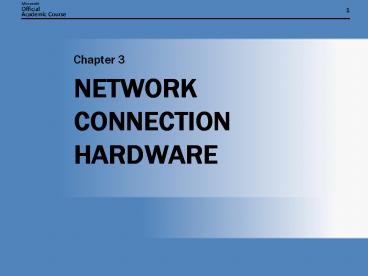NETWORK CONNECTION HARDWARE - PowerPoint PPT Presentation
1 / 20
Title:
NETWORK CONNECTION HARDWARE
Description:
NETWORK CONNECTION HARDWARE NETWORK INTERFACE ADAPTER Provides the link between a computer and the network Requires a device driver to perform both data-link and ... – PowerPoint PPT presentation
Number of Views:36
Avg rating:3.0/5.0
Title: NETWORK CONNECTION HARDWARE
1
NETWORK CONNECTION HARDWARE
- Chapter 3
2
NETWORK INTERFACE ADAPTER
- Provides the link between a computer and the
network - Requires a device driver to perform both
data-link and physical layer functions - Plugs into a bus slot or universal serial bus
(USB) port on a computer - Also referred to as a network interface card (NIC)
3
A NETWORK INTERFACE ADAPTER
4
TRANSMISSION FUNCTIONS
- Network interface adapters perform the following
functions during data transmission - Data transfer, buffering, and encapsulation
- Media Access Control (MAC)
- Parallel/ serial conversion
- Signal encoding and amplification
5
HALF-DUPLEX AND FULL-DUPLEX MODES
6
INSTALLING A NETWORK INTERFACE ADAPTER IN A
COMPUTER
- To install a network interface adapter
- Physically insert the network interface adapter
card into the slot. - Configure the card to use the appropriate
hardware resources. - Install the cards device driver.
7
A NETWORK INTERFACE ADAPTER IN A COMPUTER
8
NETWORK INTERFACE ADAPTER DEVICE DRIVERS
- Network interfaces require a device driver to
provide the link between the computer and the
interface. - Operating systems ship with device drivers for
common interfaces. - Operating systems that support PnP detect and
configure the interface automatically. - You can get drivers from the manufacturers Web
site. - The driver configuration must match the
interfaces resource settings.
9
TROUBLESHOOTING A NETWORK INTERFACE ADAPTER
- To troubleshoot the suspect network interface
adapter, open the computer case and do the
following - Verify that the interface is seated properly in
the bus slot. - Remove the card, clean the slot, and then reseat
the card in the same slot or try another slot. - Test a different interface (known to be
functional) in the same slot and in a different
slot
10
HUBS, REPEATERS, AND CONCENTRATORS
- Hubs, repeaters, and concentrators are all
physical layer devices that - Amplify and repeat signals
- Extend the distance of a network
11
AN ETHERNET REPEATER
12
10BASE-T AND 100BASE-X HUBS
- 10Base-T and 100Base-TX/100Base-T4 standards
define Ethernet networks that function at 10 Mbps
and 100 Mbps, using baseband signaling over
twisted-pair wire. - 10Base-T
- Maximum distance limitation for each connection
100 meters, including workstation-to-hub and
hub-to-hub connections - Can have up to four hubs connected to form a
hierarchical star - Includes an internal crossover circuit
- Uses an uplink port to form a hierarchical star
13
10BASE-T AND 100BASE-X HUBS (CONT.)
- 100Base-TX and 100Base-T4
- There are two types of hubs Class I and Class
II. - The maximum distance for each node connection is
100 meters. - Class II hub-to-hub connections can be no more
than 5 meters long.
14
HUB CONNECTIONS
15
10BASE-T HUB
16
ROUTERS
- Routers are network layer devices that connect
LANs. - Connect similar or different data-link layer LANs
- Must understand and support the network layer
protocol and addressing - Perform fragmentation
- Strip the data-link header and footer off
received frames - Add a new data-link header and footer before
transmitting frames - Use routing protocols to build routing tables and
forward frames - Define separate broadcast domains
17
A SIMPLE ROUTED NETWORK
18
A ROUTED INTERNETWORK
19
GATEWAYS
- Can include the functions of all seven layers of
the OSI model - Connect dissimilar systems and protocols
- Perform translation and conversion services
20
SUMMARY
- Network interface adapters provide the physical
link between computers and the network. - Hubs are physical layer devices that amplify and
repeat signals out all ports except the one they
were received through. - Routers are network layer devices that forward
datagrams between LANs. - Gateways translate and convert protocols between
dissimilar systems.































